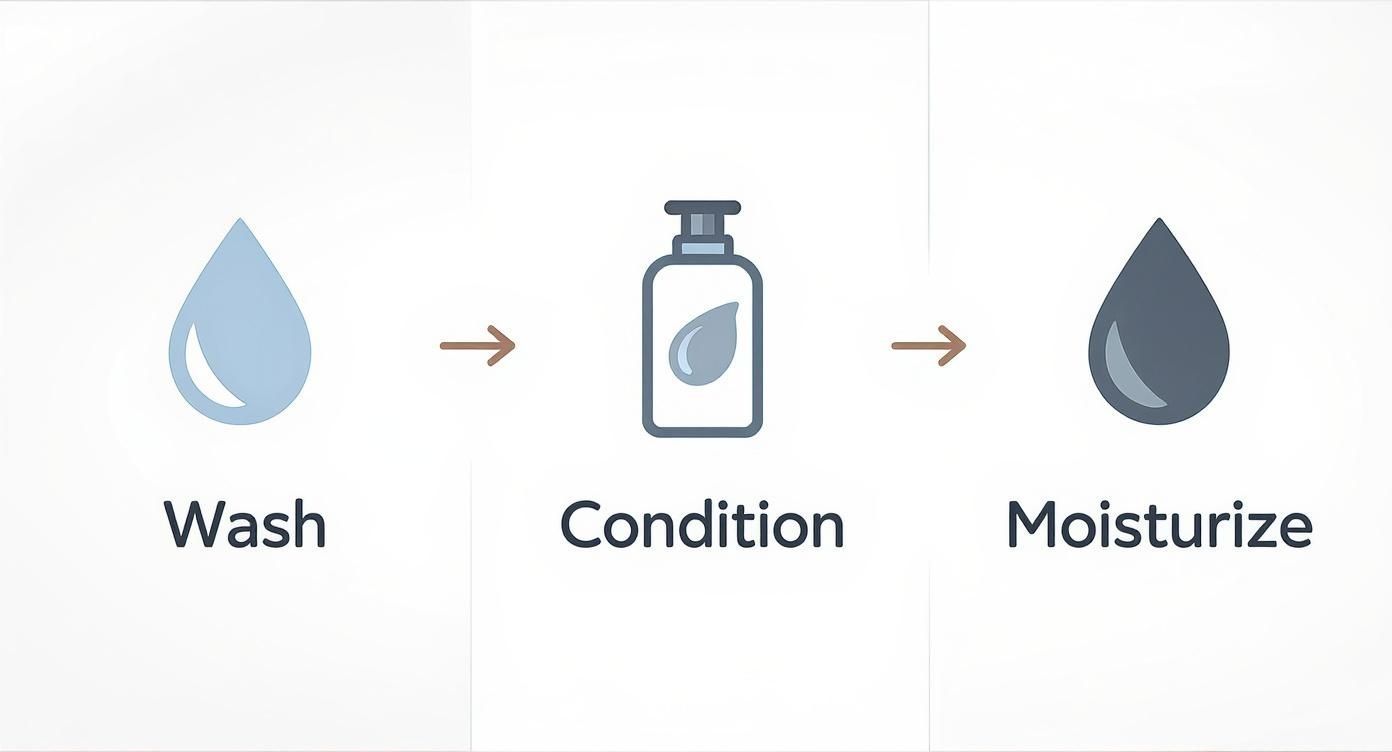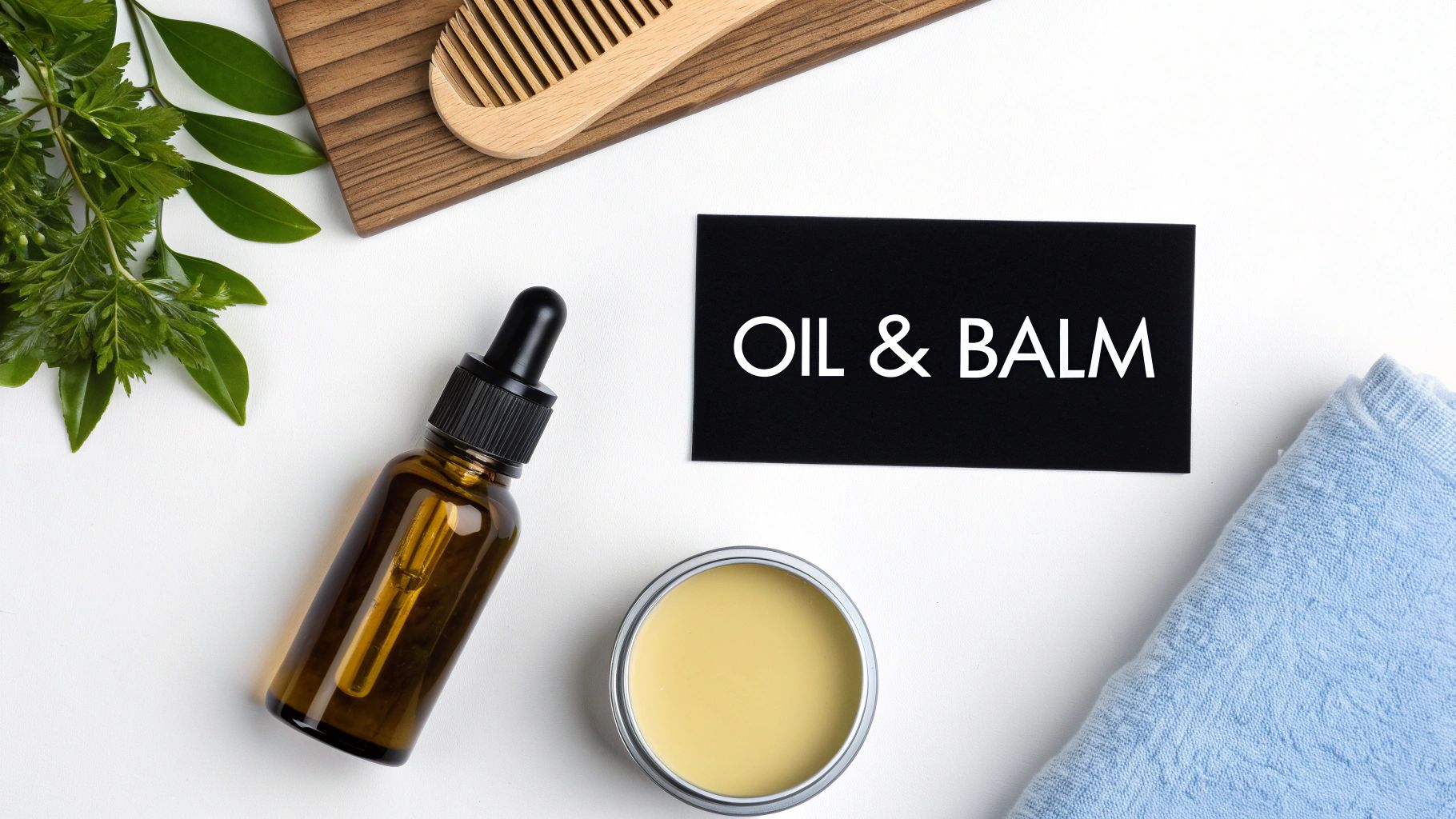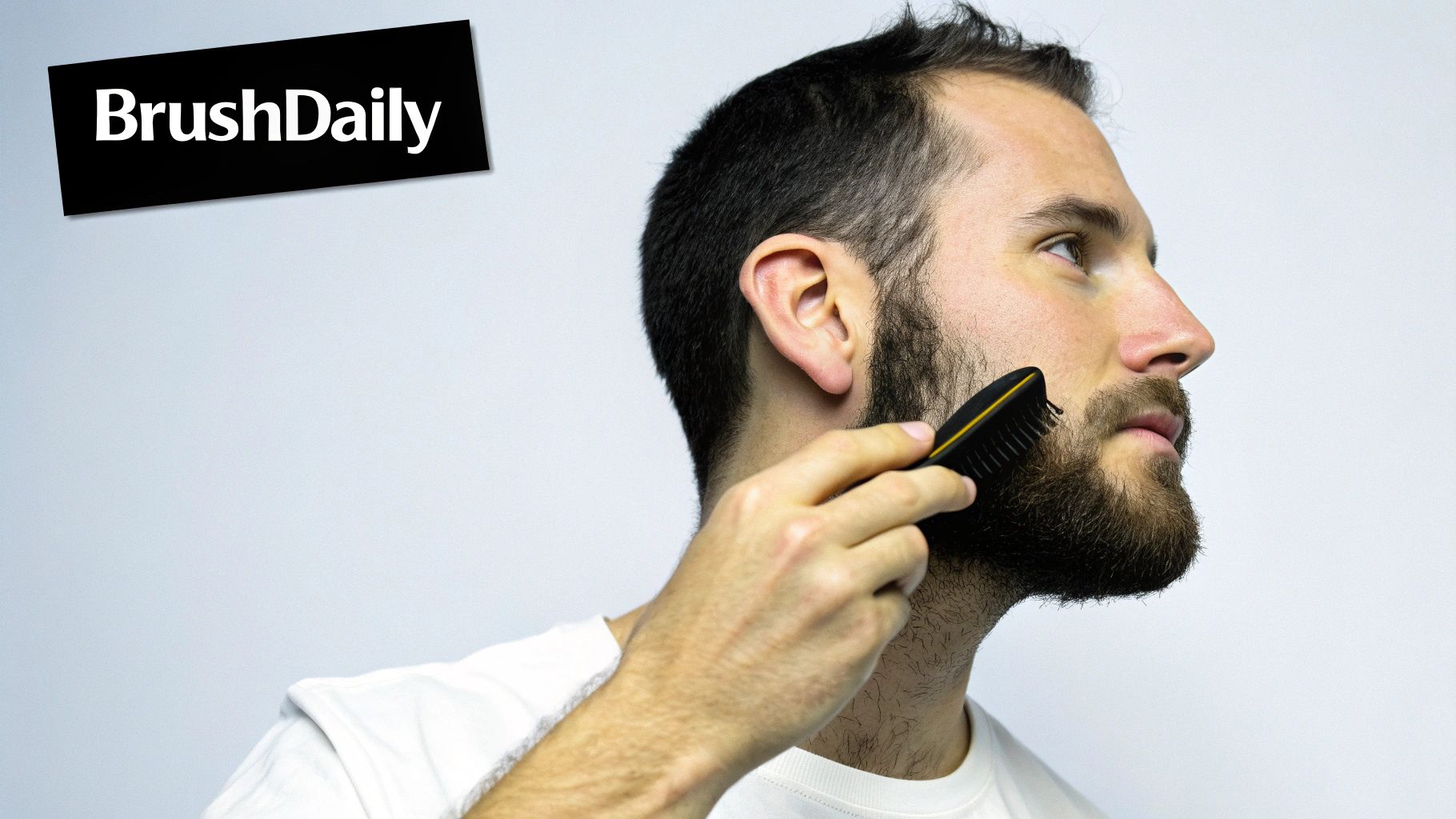Jan Elvis
14.11.2025

Jan Elvis
14.11.2025
If your beard feels more like a wire brush than a soft blanket, you're not alone. The good news is that turning that coarse, scratchy mess into something genuinely touchable comes down to a consistent routine. It's all about three things: washing it right, conditioning it well, and moisturizing it daily with something like a quality beard oil.
Get those three steps down, and you’re on your way.
So, what’s behind that wiry, uncomfortable feeling? A rough beard is almost always a sign that your facial hair—and the skin underneath it—is seriously thirsty. Once you understand what’s causing the dryness, you can start to fix it for good.
First off, beard hair is just built differently. It's what's known as androgenic hair, meaning its growth is fired up by hormones like testosterone. This naturally makes it thicker and coarser than the hair on your head.
While the hair structure plays a role, several other culprits are usually at play. Your skin produces a natural oil called sebum, which is your body's built-in moisturizer. But if you’re using harsh soaps or head shampoo on your face, you’re stripping those essential oils away, leaving your beard brittle and dry.
Your environment also has a bigger impact than you might think:
The reality is that almost every coarse beard can be softened. It's less about genetics and more about adopting the right daily habits to restore and maintain proper hydration.
This isn't some niche problem. The global beard softener industry was valued at around USD 0.81 billion in 2023 and is projected to keep growing. You can dig into the numbers in this grooming industry report. That kind of market growth tells you one thing: a lot of guys are looking for a solution.
Let's quickly break down the most common reasons for a rough beard and the first things you should do to start turning things around.
This table gives you a snapshot of the main culprits behind a scratchy beard and your first line of attack for each.
| Cause | What's Happening | First Step to Fix It |
|---|---|---|
| Harsh Soaps | Standard soaps and shampoos strip away your natural sebum oil, leaving hair dry and brittle. | Switch to a dedicated beard wash that cleanses gently without removing essential moisture. |
| Dehydration | Your beard hair is porous and loses moisture to the environment, especially in dry climates. | Start using a daily beard oil or balm to seal in moisture and protect the hair. |
| Hard Water | Mineral deposits from tap water build up on the hair shaft, making it feel stiff and rough. | Use a clarifying beard wash occasionally or consider a shower filter to reduce mineral content. |
| Lack of Conditioning | Without proper conditioning, the hair cuticles remain open and rough, leading to a wiry texture. | Introduce a dedicated beard conditioner into your routine to use after every wash. |
Think of this as your starting checklist. Nailing these basics will set the foundation for a much softer, healthier beard.
The path to a softer, more touchable beard starts right at the sink. But before you grab any old bottle, let’s get one thing straight: your regular hair shampoo is your beard’s worst enemy. It’s engineered to strip the heavy oils from your scalp, which is way too aggressive for the more delicate skin on your face. Using it on your beard is a fast track to that dry, wiry, brillo-pad texture we all want to avoid.
What you need is a dedicated beard wash. These cleansers are specifically formulated to be gentle, clearing out the daily grime and product buildup without stripping away the natural sebum that keeps your beard and skin underneath healthy and hydrated.
First things first, turn down the heat. Always use lukewarm water when you wash your beard. Scalding hot water will only strip away more of those crucial oils and can irritate your skin, while cold water just doesn't clean as effectively.
When you're washing, gently massage the product all the way down to the roots. This is where oil, sweat, and dead skin cells love to hang out. Getting down to the skin not only ensures a proper clean but it's also your first line of defense against itchiness and flakes. If you're struggling with that, we've got a whole guide on handling dry flaky skin under beard you should check out.
Once you’ve rinsed out the wash, it’s time for the real game-changer: a quality beard conditioner. Think of it this way—the wash opens up the hair cuticle to clean it, and the conditioner comes in right after to replenish moisture and seal that cuticle back down. That sealed cuticle is what gives you that smooth, soft finish.
This simple wash-and-condition process is the foundation for transforming your beard's texture.

As you can see, the routine doesn’t stop when the water turns off. Applying a moisturizer like beard oil or balm afterward is non-negotiable for locking in that softness all day.
It's all about finding the right balance. Over-washing will leave your beard brittle, but skimping on conditioning will leave it thirsty. I'd recommend washing 2-3 times per week. On the off days, you can "co-wash"—just rinse with water and use conditioner—to keep things fresh and hydrated without overdoing it.
As you build out your routine, it pays to be a conscious consumer. It’s worth looking into the importance of avoiding toxic chemicals in grooming products to understand what you're actually putting on your face.
This shift toward better ingredients and routines isn't just a niche trend. The global market for beard grooming products was valued at USD 21.87 billion in 2022 and is projected to skyrocket to USD 38.14 billion by 2030. That's a whole lot of guys deciding to treat their beards right.
If a solid wash routine is your foundation, then think of oils and balms as the finishing touches that truly elevate your beard's softness. A lot of guys think they're interchangeable, but they actually do very different jobs. Getting the hang of both is a game-changer for anyone tired of a scratchy, wiry beard.
Your beard oil is essentially a deep conditioner for both your hair and the skin underneath. Its main purpose is to hydrate. It gets right down to the roots, moisturizes the skin, and stops that annoying itch and flakiness dead in its tracks. This is non-negotiable for a healthy beard.
A beard balm, on the other hand, is more of a surface treatment and light styler. It coats the hair to seal in moisture, and the waxes (like beeswax) inside help tame flyaways and give your beard a bit of shape. It’s what makes your beard look put-together, not just soft.

Technique matters. Don't just slap this stuff on and hope for the best.
For beard oil, the perfect time to apply it is right after a shower. Your beard should be damp, not sopping wet. The leftover water helps the oil spread and absorb properly, trapping that moisture where you need it most.
When it comes to balm, warming it up is crucial. Scrape a small, dime-sized amount out with the back of your thumbnail. Rub it vigorously between your palms until it’s completely melted and smooth. This prevents clumps and ensures you get a nice, even coat that won’t weigh your beard down.
Pro Tip: Don't just coat the surface. Whether you're using oil or balm, make sure you work it all the way down to the skin. Massaging the product into the roots is the secret to growing softer, healthier hair from the follicle up.
Always check the label. The ingredients list will tell you everything you need to know about a product's quality. You want to see natural oils and butters that are known for their softening power.
The market for these products is huge. It's interesting to note that synthetic formulas actually made up about 30.5% of the beard oil market, primarily because they are engineered for maximum conditioning. To figure out what is good beard oil for you, it helps to understand what these ingredients do. The choice between natural and synthetic really just boils down to your personal preference and what your beard responds to best.
You can slather on the best oils and conditioners in the world, but if you're not physically working them through your beard, you're missing a massive piece of the puzzle. Brushing and combing every day is the mechanical side of softening your beard—it’s how you literally train the hairs to behave.
Think of it like this: You can water and fertilize a lawn, but it's the mowing and raking that really make it look manicured and healthy. Your beard isn't any different.

When it comes to daily grooming, a boar bristle brush is your absolute best friend. Those stiff, natural bristles are phenomenal for a couple of reasons:
Brushing daily also starts to train those wild, stubborn hairs to grow in the same direction. Over time, your whole beard will lie flatter and feel noticeably softer.
Here's a pro tip: Never brush a bone-dry beard. It's a recipe for static and breakage. I always recommend applying a few drops of beard oil first to give the bristles some slip and help them glide through smoothly.
If you've got a bit of length to your beard, a good wooden comb is non-negotiable, especially right after you've put in your oil. Cheap plastic combs are notorious for creating static and snagging on knots, which can cause damage. A wooden one just glides right through.
I use a comb to gently work through any tangles right after a shower. This gets all the knots out before I follow up with a brush or balm. It’s these small, consistent habits that really separate a decent beard from a great one. Learning these little tricks is a core part of a solid routine, and there are a ton of other simple grooming tips for men that can completely elevate your look.
What you do all day has a bigger effect on your beard than you might think. We can talk about oils and balms until we're blue in the face, but genuine, lasting softness starts from the inside out. The good news? A few small tweaks to your daily routine can make a massive difference.
It really does start with something as simple as drinking enough water. When you're dehydrated, your body has to make choices, and keeping your beard hair soft and pliable isn't at the top of its priority list. That moisture gets redirected to your vital organs, leaving your hair follicles high and dry. The result is a brittle, coarse beard that's just waiting to snap.
Your diet is just as important as any product you put on your beard. The right nutrients are literally the building blocks for strong, healthy hair. Think of it this way: you can't build a solid house with flimsy materials.
Certain vitamins and minerals are absolute powerhouses for hair health.
If you're serious about improving your beard from a foundational level, it's worth learning about the best vitamins for skin, hair, and nails.
Remember: The hair you see today started growing weeks ago. Improving your nutrition now is an investment in the softer, healthier beard that will grow in over the coming months.
Finally, let’s talk about a common mistake I see all the time: frying your beard with a hairdryer. Blasting it on high heat literally boils the water inside the hair shaft. This creates a kind of structural damage that leads to that wiry, crispy feeling no one wants.
Instead, gently pat your beard dry with a towel after you wash it. If you absolutely have to use a hairdryer, keep it on the lowest heat and speed setting and hold it a good distance away. Honestly, though, air-drying is always your best bet for keeping that precious moisture locked in.
Even when you think you've got the routine down, questions pop up. It's totally normal. Getting your beard to that next level of soft often involves a bit of trial and error. Let's tackle some of the most common questions guys have when they're starting out.
This is the big one, and there are two parts to the answer. You'll probably feel a real difference in how soft and manageable your beard is within the first week. That immediate boost comes from finally giving your existing hair the hydration it's been craving with good washes, conditioners, and oils.
But for that deep, lasting change in your beard's texture? You've got to play the long game. It takes roughly 3-4 weeks for the new, healthier hair—the stuff that's been properly nourished from the root—to grow out and make its presence felt.
Don't get bummed out if your beard isn't perfect after a few days. The consistent habits you build in that first month are what really set the foundation for a permanently soft and healthy beard.
It's tougher, for sure, but not impossible. If you're just not a fan of beard oil, you'll need to double down on other hydrating products to pick up the slack.
At the end of the day, these methods are a solid plan B. But there's a reason everyone recommends beard oil—it's still the most efficient way to get moisture deep into the hair and, just as importantly, the skin underneath.
Yes... and no. Your genetics absolutely dictate the baseline for your hair, like how thick the strands are and whether they're curly or straight. Some guys are just born with hair that's naturally coarser than others, and no amount of product is going to change that fundamental DNA.
However, a solid grooming routine can make a massive difference in how soft even the most stubborn, wiry beard feels. I like to think of it like woodworking: you can't change a piece of oak into a piece of pine, but you can sand, treat, and polish that oak until it's unbelievably smooth. The same idea applies right here on your face.
Ready to start building a routine that actually works? Main Character has the premium grooming essentials you need to get real results. Check out our collection and find your confidence at https://www.dontlooktrash.com.